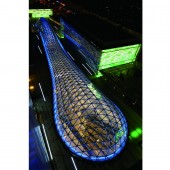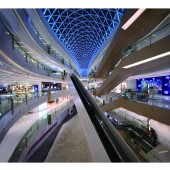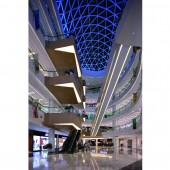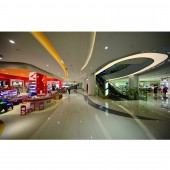
| THE AWARD |
| CATEGORIES |
| REGISTRATION |
| SUBMIT YOUR WORK |
| ENTRY INSTRUCTIONS |
| TERMS & CONDITIONS |
| PUBLICATIONS |
| DATES & FEES |
| METHODOLOGY |
| CONTACT |
| WINNERS |
| PRESS ROOM |
| GET INVOLVED |
| DESIGN PRIZE |
| DESIGN STORE |
| THE AWARD | JURY | CATEGORIES | REGISTRATION | PRESS | WINNERS | PUBLICATIONS | ENTRY INSTRUCTIONS |
Beijing Jinyu Vanke Plaza Retail by LDPi (China Branch) |
Home > Winners > Design #37643 >Interview |
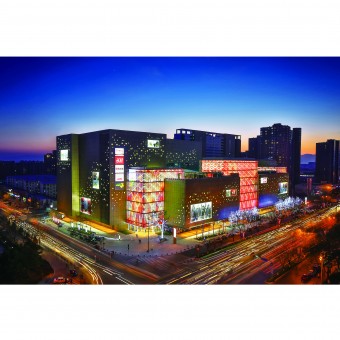 |
|
FS: What is the main principle, idea and inspiration behind your design?
LC: The idea behind the exterior lighting was to create a "magic box", that would have a very different character by day and by night, when it would come alive with color-changing lighting.
FS: What has been your main focus in designing this work? Especially what did you want to achieve?
LC: The lighting design for the facade had to directly achieve the architectural design intent from Woods Bagot, bypassing the lighting schematic design. Therefore, the design development was supplemented with various mockups to ensure a perfect "magic box" outcome which would be in sync with the main atrium's roof lighting.
FS: What are your future plans for this award winning design?
LC: We can only wish continuous prosperity to the Beijing Vanke Jiny Plaza.
FS: How long did it take you to design this particular concept?
LC: The lighting design part of the project started on December 27, 2010 in the Changping District of Beijing, China and the project had a soft opening on November 27, 2013.
FS: Why did you design this particular concept? Was this design commissioned or did you decide to pursuit an inspiration?
LC: The lighting design for the facade had to follow the architectural design intent from Woods Bagot, leaving no room for another facade lighting design.
FS: Is your design being produced or used by another company, or do you plan to sell or lease the production rights or do you intent to produce your work yourself?
LC: All of our clients' projects are uniquely designed and constructed. Therefore the lighting designs of these projects are unique.
FS: What made you design this particular type of work?
LC: Vanke values LDPi's capabilities to design the lighting for the facade, interior and landscape lighting of mixed used retails, office buildings, five-star hotels and residences.
FS: Where there any other designs and/or designers that helped the influence the design of your work?
LC: The lighting design for the facade had to follow the architectural design intent from Woods Bagot.
FS: Who is the target customer for his design?
LC: Beijing Jinyu Vanke Real Estate Development Co., Ltd.
FS: What sets this design apart from other similar or resembling concepts?
LC: All of our clients' projects are uniquely designed and constructed. Therefore the lighting designs of these projects are unique.
FS: How did you come up with the name for this design? What does it mean?
LC: The name of the project was assigned by our clients.
FS: Which design tools did you use when you were working on this project?
LC: General office software and design software (CAD, 2D rendering and lighting calculation).
FS: What is the most unique aspect of your design?
LC: The magic box is the main and unique element of this project.
FS: Who did you collaborate with for this design? Did you work with people with technical / specialized skills?
LC: LDPi China worked on the project with our client, the architect Woods Bagot, interior designer Benoy and landscape designer Aecom.
FS: What is the role of technology in this particular design?
LC: Technology either in the form of hardware, software, LED are tools that are used to make a design intent come true.
FS: Is your design influenced by data or analytical research in any way? What kind of research did you conduct for making this design?
LC: The design of the facade lighting is mostly influenced by subjective visual effects to appeal to the eyes of visitors while the design of the interior lighting is more subject to meeting local energy saving standards.
FS: What are some of the challenges you faced during the design/realization of your concept?
LC: The facade lighting design had to be confirmed with several 1:1 mockups to confirm technical lighting data (beam angles and location of anchor points) completed in cooperation with Benoy and with the support from Vanke. For the interior lighting, the challenge was to recommend lighting fixtures that would be matching several criteria: matching Vanke's limited budget, energy efficient with low maintenance cost.
FS: How did you decide to submit your design to an international design competition?
LC: Successful design deserve to be seen and if possible at an international level.
FS: What did you learn or how did you improve yourself during the designing of this work?
LC: The latest "GB 50034-2013 Standard for lighting design of buildings" implemented on June 01, 2014 mainly impacts the requirements interior lighting design. If these new standards were applied to the Jinyu Vanke project, there would be some areas, such as the atrium with the combination of functional and decorative lighting, where standards would be exceeded (sometimes with a 1:1 ratio). This gives an opportunity to work even closer with interior designers to discuss the possibility to prioritize the need for decorative lighting.
FS: Any other things you would like to cover that have not been covered in these questions?
LC: For the design of commercial spaces, it is the cooperation between all the different parties involved in that project that makes it successful. Therefore, I like to go to commercial places that are well designed: shops and brands are visible and familiar with an overall comfortable, clear, clean and well maintained environment.
FS: Thank you for providing us with this opportunity to interview you.
A' Design Award and Competitions grants rights to press members and bloggers to use parts of this interview. This interview is provided as it is; DesignPRWire and A' Design Award and Competitions cannot be held responsible for the answers given by participating designers.
| SOCIAL |
| + Add to Likes / Favorites | Send to My Email | Comment | View Press-Release |

